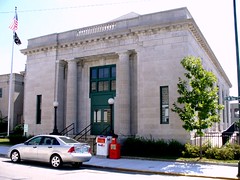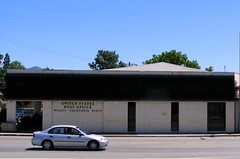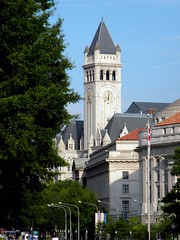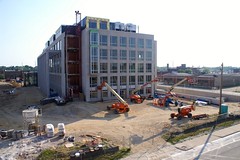Where we place government buildings matters; the Administration agrees

Posted July 15, 2010 at 1:38PM
The federal government is our nation’s largest landlord, controlling an astounding 316,000 buildings across the country. Where they are sited and how they are designed is of enormous consequence to communities and the environment.
 Consider, for example, whether a post office is within walking distance of community residents and workers, or whether it can only be reached by car. Does a federal courthouse anchor a walkable downtown neighborhood, or is it set behind a large parking lot? What about the Social Security office, or the Department of Agriculture Extension Service? The regional EPA headquarters? Did the building save a historic structure, or did its construction replace one?
Consider, for example, whether a post office is within walking distance of community residents and workers, or whether it can only be reached by car. Does a federal courthouse anchor a walkable downtown neighborhood, or is it set behind a large parking lot? What about the Social Security office, or the Department of Agriculture Extension Service? The regional EPA headquarters? Did the building save a historic structure, or did its construction replace one?
Dating back to the Carter administration, the Feds have pledged to do a better job in locating and designing federal facilities. There has been a series of relevant executive orders. But I remember attending a meeting with some coalition partners and White House folks in the late 1990s, when my friend Constance Beaumont, then with the National Trust, put it plainly: these directives “have been honored mainly in the breach.”
Congressman Earl Blumenauer has long been a champion of better attention to the location of federal facilities, authoring a simple but important bill that would require the Postal Service to consult with residents and obey local zoning ordinances and regulations before locating new post offices.  The bill would require adherence to a community’s plans for growth management, land use, traffic management, and environmental protection, all of which is rather sensible and, one would think, noncontroversial. But the legislation has been introduced in successive Congresses and has failed to generate bipartisan support, although many of his fellow Democrats have been cosponsors.
The bill would require adherence to a community’s plans for growth management, land use, traffic management, and environmental protection, all of which is rather sensible and, one would think, noncontroversial. But the legislation has been introduced in successive Congresses and has failed to generate bipartisan support, although many of his fellow Democrats have been cosponsors.
The good news is that the Obama administration appears to be taking a much more active role in addressing the problem. Earlier this month, the federal Department of Transportation, in partnership with several other agencies, issued new recommendations “to encourage sustainable locations for future government facilities.” According to the new recommended criteria, the location of federal facilities should do the following:
- Promote efficient travel and ensure access to transit to reduce the need for employees and the public to drive to the facility.
 Locate in existing central business districts and rural town centers.
Locate in existing central business districts and rural town centers.- Locate near or be accessible to affordable housing.
- Ensure the ability to walk or bike to the facility.
- Use existing buildings, infrastructure and other resources.
- Foster the development of previously developed, abandoned or underused locations known as greyfields or brownfields.
- Encourage adaptive reuse of historic buildings and districts.
- Preserve the natural environment.
- Achieve agency goals for reducing emissions as set out in their Sustainable Strategic Performance Plans.
- Discuss location alternatives with local and regional planning officials and consider their recommendations.
That’s an excellent list, and not just for the federal government. That’s not a bad summary of what all building sites should aspire to, in my humble opinion.
 Collaborators with DOT in the recommendations were its sister agencies in the federal Partnership for Sustainable Communities, HUD and EPA, plus the General Services Administration, the Department of Defense, and the Department of Homeland Security. GSA is the administrative overseer of all federal buildings, and I am especially heartened to see Homeland Security and Defense on the list. Some of the biggest challenges to community in recent years have been security-related, with barricades, locked entrances, and even agency dispersal becoming commonplace. While I suppose it is unrealistic to expect those trends to be reversed, surely their goals can be accomplished with more attention to the criteria on the list.
Collaborators with DOT in the recommendations were its sister agencies in the federal Partnership for Sustainable Communities, HUD and EPA, plus the General Services Administration, the Department of Defense, and the Department of Homeland Security. GSA is the administrative overseer of all federal buildings, and I am especially heartened to see Homeland Security and Defense on the list. Some of the biggest challenges to community in recent years have been security-related, with barricades, locked entrances, and even agency dispersal becoming commonplace. While I suppose it is unrealistic to expect those trends to be reversed, surely their goals can be accomplished with more attention to the criteria on the list.
Here’s the way the text of the recommendations puts it:
“Federal agency site decisions, while complex, represent significant opportunities through which to achieve these multiple goals. Federal, state, and local governments invest significant resources in promoting economic development, increasing affordable housing, providing transportation choices, and ensuring environmental stewardship.
They share concerns about traffic congestion, economic opportunity, and efficient use of infrastructure, and security, among many others. Agencies must consider the full range of impacts from Federal siting decisions and identify costâ€effective strategies to ensure that optimal space utilization prevails.
“The optimal Federal siting decision is the choice that meets Federal agency mission needs while also leveraging Federal development in support of other Federal and local goals. Often this is the case even where the initial cost of development may be higher. The challenge for Federal agency decision makers is to strike the right balance.”
In another portion, the document continues:
“Since the Federal Government is the nation’s single largest employer and energy user, with more than 1.8 million civilian employees, 3 providing services to the public at thousands of locations, relatively modest changes in these patterns translate into large differences in oil consumption and emissions. The physical and carbon footprint and location of Federal facilities also determine the extent to which they contribute to community revitalization rather than use undeveloped landscapes.”
Only time will tell if these recommendations create genuine change, but I am continually impressed by the commitment of this administration – especially DOT and HUD – to community sustainability.
Move your cursor over the images for credit information.